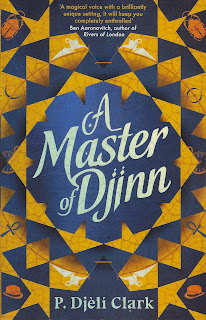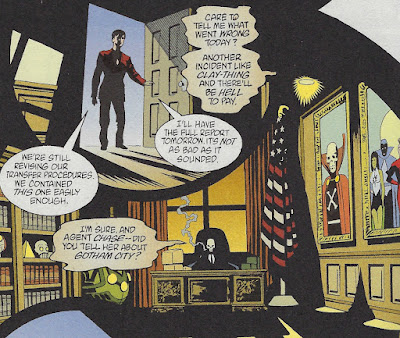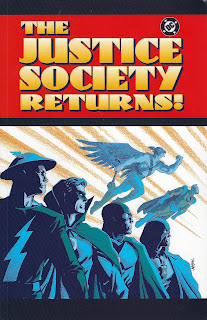The Justice Society Returns!
Writers: David Goyer, James Robinson, Chuck Dixon, Geoff Johns, Ron Marz, Tom Peyer, Mark Waid
Pencillers: Michael Lark, William Rosado, Eduardo Barreto, Scott Benefiel, Russ Heath, Aaron Lopresti, Stephen Sadowski, Peter Snejbjerg, Chris Weston, Peter Grau
Inkers: Michael Bair, Eduardo Barreto, Keith Champagne, John Dell, Wade Von Grawbadger, Doug Hazlewood, Russ Heath, Ray Kryssing, Aaron Lopresti, Mark Propst, Claude St. Aubin, Christ Weston
Colorists: John Kalisz, Carla Feeny, Noelle Giddings, Tom McCraw
Letterers: Ken Lopez, Kurth Hathaway, Bill Oakley, John Costanza, Janice Chiang
I'm coming up on the return of the JSA to an ongoing comic, but before then, I'm reading four collected editions with JSA connections, of which this is the first.
The title of this volume would seem to indicate that it's about a triumphant return of the Justice Society of America. This is only kind of true. This isn't a "return" in the narrative; the JSA (which had disbanded in Zero Hour) was still moribund in the present-day of the DC Universe (though that was about to change), it was a return out of the narrative, in that 1999 gave us a JSA title for the first time since the end of its short-lived only ongoing back in 1993. But if you were to look at my list of titles below, it's slightly deceptive: it would imply no JSA-adjacent titles from the end of Damage in 1996 until now. But in fact one had been steadily chugging along since 1994: James Robinson's Starman. This was about the most recent inheritor of the Starman mantle, but it had played a lot with the history of the character, including his JSA ties. That title was primarily written by James Robinson, often co-plotted by David Goyer, and it's those two that primarily guide this storyline.
 |
Did people in 1945 know this? I guess probably.
from All Star Comics vol. 2 #1 (script by James Robinson & David Goyer, art by Michael Lark and Wade Von Grawbadger & Doug Hazlewood)
|
The Justice Society Returns! is set in 1945, as it seems World War II is coming to an end, and one could imagine it as a story arc in
All-Star Squadron if the series had made it that far along; like that series, it weaves the superheroics in and out of real war to good effect. It is structured like a typical Golden Age JSA storyline: the characters as a group discover some issue, then they split up into groups to handle different aspects of it, then they come back together as a group to finish it off. Except, instead of having just a single issue to do all of this,
JSA Returns takes nine issues, two of which are double-sized!
This turns out to really work. I usually dislike the typical JSA structure because everything is rushed and you don't get much genuine character interaction—which is surely what you want out of a team book! But with one issue apiece for each pair of heroes, you can really dig into them. The individual stories, like All-Star Squadron did, do neat stuff by placing these superheroes in wartime, exploring what makes them tick, and delving into the war itself at the same time. Goyer and Robinson write the two framing issues (All Star Comics vol. 2 #1-2, more on them later), while a variety of writers pen the ones in between; each issue has its own artist.
 |
Good use of the silent panel, here.
from All-American Comics vol. 2 #1 (script by Ron Marz, art by Eduardo Barreto)
|
Highlights included "Cold Heart" (All-American Comics vol. 2 #1), which is about Green Lantern and Johnny Thunder protecting the Yalta Conference, but is mostly told from the perspective of an ordinary American soldier trying to do the same without superpowers: a strong sense of tone, time, and character make this an effective tale. It might be the best Ron Marz script I've ever read, and Eduardo Barreto is a great penciller who I am surprised not to know more of given this quality of work.
 |
Go little guy, go!
from Adventure Comics vol. 2 #1 (script by James Robinson & David Goyer, art by Peter Snejbjerg & Keith Champagne)
|
I also really liked "Stars and Atoms" (Adventure Comics vol. 2 #1), which sends Starman and the Atom to Los Alamos to protect the atom bomb test site. Robinson and Goyer themselves provide a great focus on one of my favorite JSAers, the eternal underdog the Atom, and Peter Snejbjerg (is he an underrated talent? I always like him but can't remember seeing him get much high-profile stuff) also turns in some atmospheric pencils, backed up by great coloring from John Kalisz. The debt that this whole series owes to A-SS is most clear here, as it picks up on some stuff Roy Thomas established about how the Atom developed superpowers and changed costumes (though I think that "really" didn't happen until 1948).
 |
I don't think I've ever read a comic really focused on Mr. Terrific, but I usually enjoy him when he pops up.
from National Comics vol. 2 #1 (script by Mark Waid, art by Aaron Lopresti)
|
It would probably surprise no one to know that Mark Waid's story is also one of the collection's greats. "Fair Play" (
National Comics vol. 2 #1) is set in Dresden during the Dresden bombing, focusing on the Flash and Mr. Terrific. The story is narrated by the Flash, but focuses on Mr. Terrific, whose sense of fair play is undermined by the horrific events he witnesses... perpetrated by his own side! The ending is a little pat, though, as the story kind of punts responsibility for the bombing onto war itself rather than, you know, the people who make these decisions.
 |
Gotta get our gratuitous shots into those comics about women, amirite?
from Sensation Comics vol. 2 #1 (script by James Robinson & David Goyer, art by Scott Benefiel & Mark Propst)
|
Probably the only misfire is "Womanly Deeds & Manly Words" (Sensation Comics vol. 2 #1). The writing here from Robinson & Goyer is fine, teaming up Wonder Woman and Hawkgirl, but it is pretty typical superhero comics that clearly someone involved went, "Well, why would people read a comic about two women unless it had a lot of panels with gratuitous focuses on tits, asses, and panties in it?" I don't know this Scott Benefiel guy, and I am not encouraged to do so. The Wonder Woman here is Diana's mother, Queen Hippolyta, having travelled back in time (I think this happened in John Byrne's Wonder Woman comics, which I haven't read), but the story mostly shies away from that; aside from Johnny Thunder calling her "Polly" in one issue, I don't think there's a reference. (Roy Thomas established back in All-Star Squadron/Secret Origins that Miss America filled Wonder Woman's role in the JSA in the post-Crisis timeline, but later writers don't seem to have been very interested in that idea.)
 |
I have never really been convinced I want to read a Johnny Thunder series or something, but I have come to see him as a delightful bit of color in JSA stories.
from All Star Comics vol. 2 #1 (script by James Robinson & David Goyer, art by Michael Lark and Wade Von Grawbadger & Doug Hazlewood) |
I also was not very taken by the wrap-up issue, "Time's Arrow" (
All Star Comics vol. 2 #2), which becomes a confusing muddle involving time travel for no evident reason. It felt like the writers ran out of space... but they only ran out of space because they added a bunch of unnecessary stuff! But the first issue, "Time's Keeper" (
All Star Comics vol. 2 #1), was a strong one; it's essentially two one-issue stories combined: first an Hourman solo story, then a big JSA fight. I can't claim to love Hourman (I would be very happen to never read another ham-fisted Miraclo addiction storyline), but he can work well in some cases, and this is one of them. Michael Lark, better known for his work on
Gotham Central, is just as adept with traditional superheroics.
(There are also two short stories that pad out the volume, one about class snobbery in the JSA from Golden Age Secret Files and Origins #1, and one about Stargirl from JSA Secret Files and Origins #1. The former was fun, but the latter did not make me like Stargirl very much. I am curious to see her in her original solo series, which I should do soon.)
Overall, this is great, doing what the "retroactive continuity"–based JSA comics have done at their best since the days of All-Star Squadron, and I am glad I spent the money to track down a physical copy. Soon I'll be reunited with the JSA in the present (there is a veritable explosion of JSA content in the early 2000s) but this is a great teaser for things to come, a great return to the glory days.
This post is twenty-fifth in a series about the Justice Society and
Earth-Two. The next installment covers Chase. Previous installments are listed
below:
-
All Star Comics: Only Legends Live Forever (1976-79)
-
The Huntress: Origins
(1977-82)
-
All-Star Squadron
(1981-87)
-
Infinity, Inc.: The Generations Saga, Volume One
(1983-84)
-
Infinity, Inc.: The Generations Saga, Volume Two
(1984-85)
-
Showcase Presents... Power Girl
(1978)
-
America vs. the Justice Society
(1985)
-
Jonni Thunder, a.k.a. Thunderbolt
(1985)
-
Crisis on Multiple Earths, Volume 7
(1983-85)
-
Infinity, Inc. #11-53
(1985-88) [reading order]
- Last Days of the Justice Society of America (1986-88)
- All-Star Comics 80-Page Giant (1999)
- Steel, the Indestructible Man (1978)
- Superman vs. Wonder Woman: An Untold Epic of World War Two (1977)
- Secret Origins of the Golden Age (1986-89)
- The Young All-Stars (1987-89)
- Gladiator (1930) ["Man-God!" (1976)]
- The Crimson Avenger: The Dark Cross Conspiracy (1981-88)
- The Immortal Doctor Fate (1940-82)
- Justice Society of America: The Demise of Justice (1951-91)
- Armageddon: Inferno (1992)
- Justice Society of America vol. 2 (1992-93)
- The Adventures of Alan Scott--Green Lantern (1992-93)
- Damage (1994-96)

































